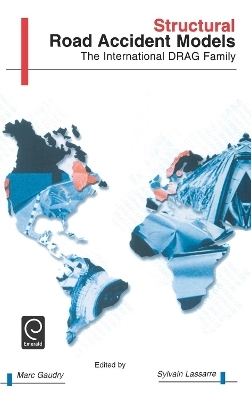
Structural Road Accident Models
Pergamon Press (Verlag)
978-0-08-043061-4 (ISBN)
- Lieferbar (Termin unbekannt)
- Versandkostenfrei innerhalb Deutschlands
- Auch auf Rechnung
- Verfügbarkeit in der Filiale vor Ort prüfen
- Artikel merken
DRAG (from un modele de la Demande Routiere, des Accidents et leur Gravite) is a complex computer model that simulates accident propensities under detailed conditions. The DRAG approach constitutes the largest road accident modelling effort ever undertaken. Gaudry is the creator and developer of DRAG and this work explains its nature, purpose and value. Such a model, which explains accidents for a whole region, province or country, has advantages in answering many questions asked about accidents (such as the role of the economic cycle, weather, prices, insurance etc.) that other models fail to take fully into account. DRAG research is underpinned by a fundamental theoretical innovation which sees a 3-level approach to analysing the determinants of the number of road victims in a given accident: Exposure (the distance travelled), Accident Frequency Risk and Accident Severity Risk (i.e. the number of victims of each type of accident). In applying flexible mathematical forms, the DRAG model also allows significant conceptual and empirical claims to be made about the importance of detecting responses that reverse themselves (to alcohol, and to other factors). Under Gaudry's guidance, a family of DRAG-inspired models has grown up, based on their development for different countries and this book explores each national model in turn. As more countries seek to adopt the DRAG approach, this book serves as a timely, unique and valuable guide to the model.
Part and chapter headings: National and Regional Models. Multiple Levels, Damages, Forms, Movements and Variables in Road Accident Models (M. Gaudry).
The DRAG-2 Model for Quebec (F. Fournier, R. Simard).
The SNUS-2.5 Model for Germany (U. Blum, M. Gaudry).
The TRULS-1 Model for Norway (L. Fridstrom).
The DRAG-Stockholm-2 Model (G. Tegner et al.).
The TAG-1 Model for France (L. Jaeger, S. Lassarre).
The TRACS-CA Model for California (P. McCarthy).
Comparing Six DRAG-Type Models (N. Chambron).
Other Models and Issues. The Road, Risk, Uncertainty and Speed (M. Gaudry, K. Vernier).
The RES Model by Road Type in France (R. Bergel, B. Girard).
PostFACE and Perspectives (S. Lassarre).
Algorithms and Detailed Model Outputs. TRIO Level-1.5 Algorithm for BC-GAUHESEQ Regression (T. Liem et al.).
The IRPOSKML Procedure of Estimation (L. Fridstrom).
Appendix 1. Detailed Model Outputs (M. Gaudry, S. Lassarre).
| Erscheint lt. Verlag | 17.11.2000 |
|---|---|
| Verlagsort | London |
| Sprache | englisch |
| Maße | 156 x 234 mm |
| Gewicht | 698 g |
| Themenwelt | Informatik ► Grafik / Design ► Digitale Bildverarbeitung |
| Technik ► Fahrzeugbau / Schiffbau | |
| ISBN-10 | 0-08-043061-9 / 0080430619 |
| ISBN-13 | 978-0-08-043061-4 / 9780080430614 |
| Zustand | Neuware |
| Haben Sie eine Frage zum Produkt? |
aus dem Bereich


